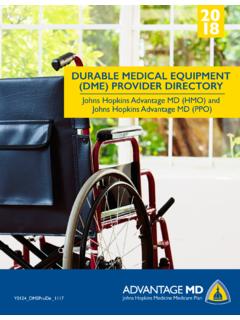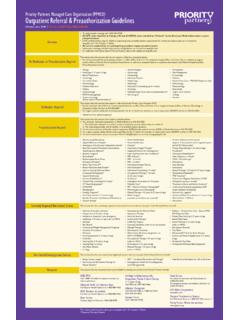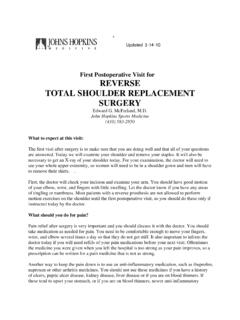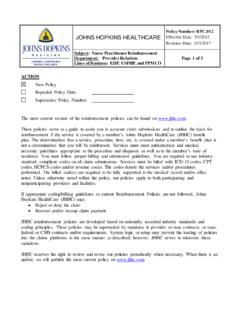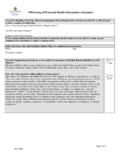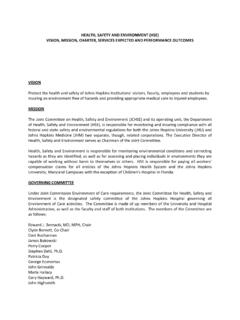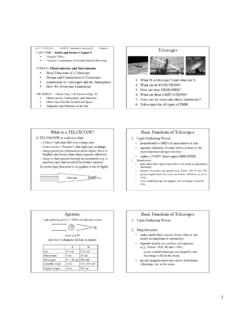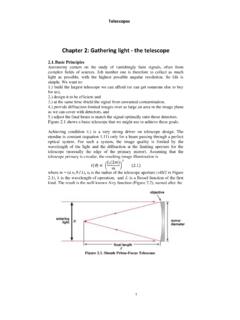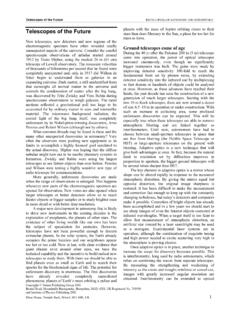Transcription of Implantable miniature Telescope - Johns Hopkins Hospital
1 Spotlight on Low-Vision Services Implantable miniature Telescope The first-ever technology approved for end-stage age-related macular degeneration. By Tiffany L. Chan, OD. A. ge-related macular degeneration (AMD) is a progressive retinal condition and is the leading cause of legal blindness in individuals over the age of 60 years. In the United States, approxi- mately million people suffer from AMD, and the number is expected to increase to 3 million by It is estimated that approximately 30% of adults older than 75 have some signs of AMD, and approximately 10% of them demonstrate advanced or late stages of the Progression of AMD can lead to a decline in the abil- ity to see fine detail and a loss of central vision in one or both eyes (Figure 1).
2 As AMD worsens, patients will frequently develop irreversible retinal damage, includ- ing large areas of atrophy or scarring in the macula. For patients with advanced AMD, this loss of central vision can have a significant impact on their ability to perform activities of daily living, including reading, recognizing faces, and driving. The Beaver Dam Eye Study showed that poor visual acuity, poor contrast sensitivity, and a discrepancy in vision between the two eyes were posi- tively correlated with the risk of The study also found that vision impairment is an independent risk fac- tor of mortality with a hazard ratio of Figure 1. End-stage AMD is the leading cause of blindness Until now, there have been no medical treatment in the United States.
3 The disease creates a permanent options to offer patients with end-stage AMD. Therapies central vision blind spot making it difficult or impossible to targeting vascular endothelial growth factor have greatly recognize even close family or friends. improved outcomes for neovascular or wet If fibrosis or scarring occurs, however, the sight-threatening THE Implantable miniature Telescope . damage is irreversible. Similarly, no medical interventions The Implantable miniature Telescope (IMT, are available to reverse retinal damage seen in patients VisionCare Ophthalmic Technologies) is the first surgi- with advanced atrophic or dry macular degeneration. cal intervention approved for patients with end-stage To maximize the remaining vision, low-vision rehabilita- AMD (Figure 2).
4 It was approved by the US Food tion and visually assistive equipment should be imple- and Drug Administration in July 2010. The Telescope mented to help patients with managing tasks and to implant is an intraocular visual prosthetic device, which enhance independence and functioning with their daily is inserted into the lens capsule during cataract extrac- activities. tion in lieu of a traditional IOL (Figure 3). The power of may/june 2013 Advanced ocular care 1. Spotlight on Low-Vision Services Figure 2. Smaller than a pea, the Telescope implant uses wide-angle micro-optics to improve vision for patients with end-stage AMD, the most advanced form of macular Figure 4. CentraSight's Implantable Telescope technology degeneration.
5 Reduces the impact of the central vision blind spot due to end-stage AMD. The Telescope implant projects the objects the patient is looking at onto the healthy area of the light- sensing retina not degenerated by the disease. the likelihood of complications, are criteria for exclu- sion such as pseudoexfoliation, corneal dystrophies, optic nerve disorders, or pathology that compromises peripheral vision in the fellow eye. PRE- AND POSTOPERATIVE. CONSIDERATIONS. Both before and after surgery, patients work closely with low-vision specialists and occupational therapists to ensure that they will be able to utilize the device fully. An external Telescope simulator helps to dem- onstrate the telescopic power prior to surgery.
6 With Figure 3. The tiny Telescope is implanted in place of the eye's this simulator, the patient is able to appreciate the lens to help improve vision in patients with end-stage AMD. visual enhancements made with the Telescope , but also importantly, understand the limitations of the device. Like any Telescope , the image is larger, but the field of the miniature Telescope helps to magnify images two to view is reduced. The Telescope implant has a field of three times their original size with the goal of improv- view of approximately 20 . As stated previously, the ing the central vision in one eye of patients with mod- Telescope is implanted into one eye. The implanted eye erate to profound visual impairment (Figure 4).
7 Will be responsible for detailed vision, and the fellow or Patient selection for the Telescope prosthesis is criti- nonsurgical eye will be responsible for peripheral vision cal, and there is an extensive screening process involved tasks, including ambulation. (Table). It is approved for patients 75 years or older Although the Telescope implant can provide with stable, bilateral, end-stage AMD with either geo- approximately two to three times magnification, a graphic atrophy or disciform scarring involving the person with end-stage AMD will still require glasses fovea. Visual acuity criteria include a BCVA of 20/160 to and visually assistive equipment after the procedure. 20/800 in the better-seeing eye.
8 The Telescope implant This is an important aspect that patients need to be is implanted into one eye and, at this time, candi- educated about. Additionally, driving is contraindi- dates cannot have had prior cataract surgery in that cated, even if the individual meets the vision require- eye. Many ocular comorbidities, which may increase ments in his or her state. From a practical standpoint, 2 Advanced ocular care may/june 2013. Spotlight on Low-Vision Services Table. Eligibility Requirements Summary of patient eligibility criteria for the Early studies demonstrate a Implantable miniature Telescope : statistically significant 1. At least 75 years of age 2. Bilateral, stable end-stage AMD with retinal findings improvement of vision in eyes of geographic atrophy or disciform scar with foveal with the implanted Telescope involvement compared with control eyes.
9 3. BCVA of 20/160 to 20/800 in the better-seeing eye 4. Evidence of a cataract in the eye considered for the Implantable Telescope 5. Be willing to undergo preoperative screening and corneal edema, the initial postoperative vision may postoperative training with a low-vision specialist and/or be poor and underestimate the final visual outcome. occupational therapist Postsurgical sessions with low-vision specialists will focus on assisting the patient to appreciate and stabi- lize the telescopic image. (Courtesy of James Gilman). A potential risk related to the procedure is cor- neal endothelial cell loss that can affect overall cor- neal health. The most common complication of the Implantable Telescope procedure was inflammatory CONCLUSION.
10 Early studies demonstrate a statistically significant improvement of vision in eyes with the implanted tele- scope compared with control eyes. Approximately 90%. of patients demonstrated 2 or more lines of improve- ment on the ETDRS (Early Treatment of Diabetic Retinopathy Study) visual acuity chart, and 67% of patients were able to see 3 or more lines on the eye chart after the surgery compared with before the sur- Most patients are able to appreciate improved facial recognition. Although it is not a cure for the Figure 5. The Implantable Telescope technology helps disease, the Implantable Telescope has the potential to improve vision in patients with the most advanced form of make a positive difference in the lives of some people macular degeneration, end-stage AMD, while being virtually with end-stage AMD (Figure 5).
